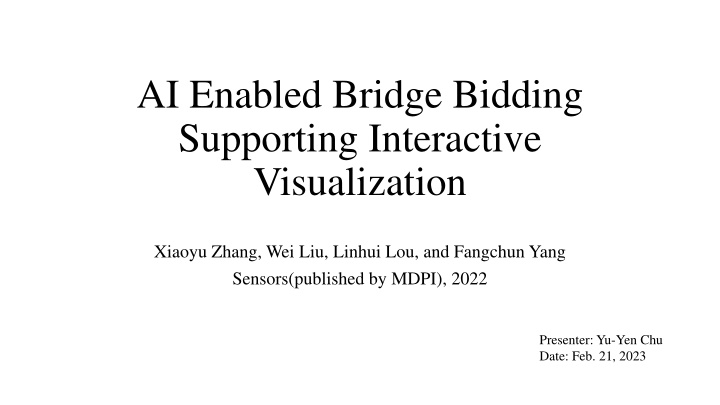
Cutting-Edge AI Bridge Bidding Service Framework
"Explore a groundbreaking AI framework for bidding in bridge games, featuring a deep neural network model and interactive visualization. This innovative system outperforms existing solutions, offering enhanced decision-making support and human-computer interaction capabilities."
Download Presentation

Please find below an Image/Link to download the presentation.
The content on the website is provided AS IS for your information and personal use only. It may not be sold, licensed, or shared on other websites without obtaining consent from the author. If you encounter any issues during the download, it is possible that the publisher has removed the file from their server.
You are allowed to download the files provided on this website for personal or commercial use, subject to the condition that they are used lawfully. All files are the property of their respective owners.
The content on the website is provided AS IS for your information and personal use only. It may not be sold, licensed, or shared on other websites without obtaining consent from the author.
E N D
Presentation Transcript
AI Enabled Bridge Bidding Supporting Interactive Visualization Xiaoyu Zhang, Wei Liu, Linhui Lou, and Fangchun Yang Sensors(published by MDPI), 2022 Presenter: Yu-Yen Chu Date: Feb. 21, 2023
Abstract With the fast progress in perfect information game problems such as AI chess and AI Go, researchers have turned to imperfect information game problems, including Texas Hold em and Bridge. Bridge is one of the most challenging card games that have significant research value. Bridge playing is divided into two phases: bidding and playing. This paper focuses on bridge bidding and proposes a bridge bidding service framework using deep neural networks, and supports bidding visualization for the first time. The framework consists of two parts: the bidding model (BM) with a multilayer neural network, and a visualization system. The framework predicts not only reasonable bids from the existing bidding system of humans, but also provides intuitive explanations for decisions to enable human computer information interaction. Experimental results show that this bidding AI outperforms majority of existing systems. 2
Problem Setup Train a bridge bidding model (with competition). Using RNN and MLP(multi-layer perceptron). A visualization system for human-machine competition. 3
Bidding Model RNN 3 hidden layers input: bidding action, hand, vulnerability, position Multi-Layer Perceptron (MLP) a classifier with multi-layer 4 kinds of MLP (to find the probability distribution) MLP of HCP (take RNN s output as input) MLP of card amount of each suit (take RNN s output as input) MLP of each cards (take RNN s output as input) MLP of next bidding action (take RNN s output and above 3 MLPs as input) 4
Visualization System Represent the prediction results of bidding model. Let human know what a bidding action means to bidding model. 5
Experiment data Snyrey platform 4,000,000 data with bidding sequence and double dummy result. 70% training, 20% validation, 10% testing. bid and non-bid Large passes in a bidding sequence will overestimate the accuracy. bid: only compare bidding actions without pass. non-bid: compare all bidding actions. rule of rationality to check if a bidding action is rational or not 8
Result 9
Result Compare with the result in Automatic Bridge Bidding Using Deep Reinforcement Learning, Yeh, Hsieh, and Lin, 2018 . Compare with Wbridge5. 10
